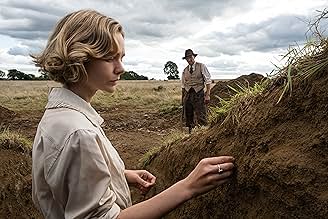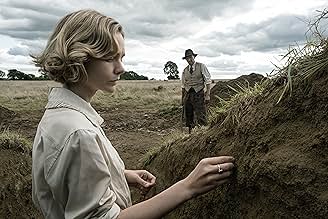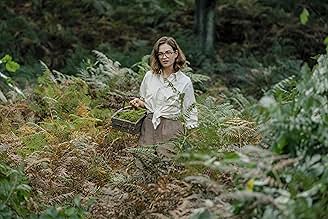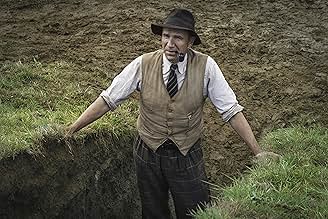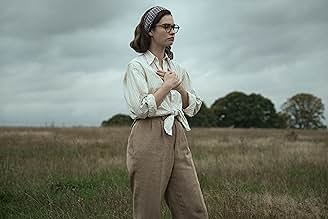A puertas de la Segunda Guerra Mundial, una viuda pudiente contrata a un arqueólogo aficionado para excavar túmulos funerarios en sus tierras.A puertas de la Segunda Guerra Mundial, una viuda pudiente contrata a un arqueólogo aficionado para excavar túmulos funerarios en sus tierras.A puertas de la Segunda Guerra Mundial, una viuda pudiente contrata a un arqueólogo aficionado para excavar túmulos funerarios en sus tierras.
- Dirección
- Guión
- Reparto principal
- Nominado a 5 premios BAFTA
- 3 premios y 11 nominaciones en total
Reseñas destacadas
This is a very good movie..if you see the picture from the outside you'll say it's a story about an Archeologist and his historically important excavation..but if you dig deeper you'll find a lot of potential in what the movie is trying to tell you.
The relationships between us and the people we love,the people we don't even know..heck between people in general and how it's important to a human being..but that comes with a misunderstandings and conflicts and this happening in a time of war and how that is affecting them..all this has been told in an amazing dramatic way of Brasil Brown who discovered and excavated one of the most important archaeological discoveries of all time of course with that being the main story.
The acting by Carey Mulligan was magnificent and Ralph Fiennes was the one for this role and their performance was the outstanding thing in the whole movie.
Another thing was good is the editing..they've done a tremendous job and it was really worth the effort to come up with something like this.
Although sometimes there are some side stories that you'll find yourself not that interested in them too much,and the storytelling could seem very slow at some points..also there's ups and downs like any other movie.
Overall great movie,worth watching and i suggest you to see it.
An intriguing little piece of British history, The Dig tells a slow-burning story with understated and genuine drama throughout, turning what could have been a rather dry tale of archaeology into a genuinely gripping character drama. Its historical context takes a little while to become fully relevant, but ultimately, The Dig really proves itself as a captivating watch.
One of the things that I really liked about The Dig was its patience. Never dragging yet never rushing, the film takes its time to build up all of its main strengths, from its characters, their emotional back stories, and the overarching historical context of the outbreak of World War II.
Complete with elegant camerawork, a beautiful score and impressively atmospheric direction that makes it an eye-catching watch from the first few moments, The Dig has enough confidence and depth to keep you engrossed even if its story isn't advancing apace, something that's a lot harder to pull off than you may think.
One of the big reasons that the film's patient pacing and style work so well is because of its understated, genuine drama. With calm yet fully convincing performances across the board, particularly from Ralph Fiennes and Carey Mulligan, this isn't a showy period drama by any means, but eases you into a story about real people, making them the centre of attention far more than the historical significance of the event.
I'm not particularly well-versed in archaeology, and I didn't know about this discovery before watching this film. I think that might be the case for many other people, but the great thing about The Dig is that it's primarily a character-driven drama, and one that uses emotional intrigue to bring you closer to the story at hand and allow you to appreciate its importance.
One element where the film does seem to falter is in its use of the historical backdrop of the lead-up to World War II. Set in the summer months of 1939 before the outbreak of war, there are sporadic references to the coming conflict through the first two acts of the movie, but they don't seem to bear much relevance to this story about an archaeological find.
However, the film slowly begins to unveil how the historical context plays into its characters' personal lives and the fate of the dig itself, with dramatic focus shifting significantly in the final act, but just at the right point that the sudden arrival of the war into everyday life feels just like what it would have been like to experience it first-hand, taking over everything seemingly normal in an instant.
As a result, while the historical backdrop seems almost contrived at first, it really comes good as the film progresses, another demonstration of how the patience of The Dig really plays into its hands throughout.
One of the things that I really liked about The Dig was its patience. Never dragging yet never rushing, the film takes its time to build up all of its main strengths, from its characters, their emotional back stories, and the overarching historical context of the outbreak of World War II.
Complete with elegant camerawork, a beautiful score and impressively atmospheric direction that makes it an eye-catching watch from the first few moments, The Dig has enough confidence and depth to keep you engrossed even if its story isn't advancing apace, something that's a lot harder to pull off than you may think.
One of the big reasons that the film's patient pacing and style work so well is because of its understated, genuine drama. With calm yet fully convincing performances across the board, particularly from Ralph Fiennes and Carey Mulligan, this isn't a showy period drama by any means, but eases you into a story about real people, making them the centre of attention far more than the historical significance of the event.
I'm not particularly well-versed in archaeology, and I didn't know about this discovery before watching this film. I think that might be the case for many other people, but the great thing about The Dig is that it's primarily a character-driven drama, and one that uses emotional intrigue to bring you closer to the story at hand and allow you to appreciate its importance.
One element where the film does seem to falter is in its use of the historical backdrop of the lead-up to World War II. Set in the summer months of 1939 before the outbreak of war, there are sporadic references to the coming conflict through the first two acts of the movie, but they don't seem to bear much relevance to this story about an archaeological find.
However, the film slowly begins to unveil how the historical context plays into its characters' personal lives and the fate of the dig itself, with dramatic focus shifting significantly in the final act, but just at the right point that the sudden arrival of the war into everyday life feels just like what it would have been like to experience it first-hand, taking over everything seemingly normal in an instant.
As a result, while the historical backdrop seems almost contrived at first, it really comes good as the film progresses, another demonstration of how the patience of The Dig really plays into its hands throughout.
So rare to watch a wonderfully gentle but poignant film. It tugs at the emotions as it tells a largely true. Some liberties are taken with the truth but largely accurate. The real story of Peggy Piggott is fascinating and worth a film in itself. However the real stars of the story are Edith Pretty and Basil Brown portrayed brilliantly by Mulligan and Fiennes. One small criticism is that Carey Mulligan is too young for the part but she carries it off superbly and the performance by Ralph Fiennes is one of the best I have seen in a long time. The whole cast is superb and the backdrop of imminent war is ever present throughout the film. I have visited Sutton Hoo a number of times and studied the excavation and I still marvel at the work Basil Brown did. As an archaeologist myself I can say his work even by today's standards was of the highest order. Many of the academic archaeologists before and after WW2 were useless when it came to excavation and recording it. Basil Brown did everything right and it is fantastic he is at last getting the credit he deserved and that Edith Pretty wanted for him. It is to the great shame of the academic establishment it has taken so long. The film portrays this extremely well.
There is a lot I can say about this film, but I'll keep it short.
If you love simple stories being told in a beautiful and clear manner, and if you like Archaeology, then this is the film for you. All of the actors have done a wonderful job.
"The Dig" (2021 release from the UK; 112 min.) reminds us at the very beginning that this is "Based On a True Story". We then go to "Suffolk, England, 1939" as Basil Brown arrives at the house of Edith Pretty. Turns out Mrs. Pretty has hired Mr. Brown to do some archeological work on her estate. Her young son excitedly asks Mr. Brown "Are you going to dig upo the mountain?". Mr. Brown, taking room and pension at Mrs. Ptretty's house, starts to dig and soon is working his way towards some intriguing finds... At this point we are 15 min. into the movie, but to tell you more of the plot would spoil your viewing experience, you'll just have to see for yourself how it all plays out.
Couple of comments: this is directed by little known Australian director Simon Stone ("The Daughter)". Here he brings us a historical drama about what later became known as the Sutton Hoo treasure, one of the biggest archeological finds in British history. The setting of 1939 is pivotal in several ways: of course the threat of WWII is in the air, but even more important, the way of life in those days was just entirely different, and being in a remote English area (near Ipswich) only reinfornces that. So be prepated for a slow moving film, I didn't mind it one bit. Even more critical for the movie is Carey Mulligan's exquisite lead performance. Playing a person who is more than 20 years her senior in real life (Carey is 35, Mrs, Pretty was in her mid-50s in 1939), she does so with grace and style and presence. The role couldn't be more different from what Carey did in the recently released "Promising Young Woman", which was in my top 3 of the bests films of 2020. Ralph Fiennes is equally great as the excavator Mr. Brown. Last but not least there is a wonderful orchestral score by Stefan Gregory, who I must admit was previously unknown to me.
"The Dig" opened last weekend in select theaters for a short run before then moving on to Netflix. (Seems like every other new theatrical release these days follows that pattern....) Thankfully the film opened at my art-house theater here in Cincinnati. The early Satruday evening screening where I saw this at was attended so-so (exactly 5 people including myself). Never mind. If you are in the mood for a good ol' fashioned hisstorical drama featuring outstanding performances from Carey Mulligan and Ralph Fiennes, I'd readily suggest you check this out, be it in the theater (if you still can), on VOD< or eventually on DVD/Blu-ray, and draw your own conclusion.
Couple of comments: this is directed by little known Australian director Simon Stone ("The Daughter)". Here he brings us a historical drama about what later became known as the Sutton Hoo treasure, one of the biggest archeological finds in British history. The setting of 1939 is pivotal in several ways: of course the threat of WWII is in the air, but even more important, the way of life in those days was just entirely different, and being in a remote English area (near Ipswich) only reinfornces that. So be prepated for a slow moving film, I didn't mind it one bit. Even more critical for the movie is Carey Mulligan's exquisite lead performance. Playing a person who is more than 20 years her senior in real life (Carey is 35, Mrs, Pretty was in her mid-50s in 1939), she does so with grace and style and presence. The role couldn't be more different from what Carey did in the recently released "Promising Young Woman", which was in my top 3 of the bests films of 2020. Ralph Fiennes is equally great as the excavator Mr. Brown. Last but not least there is a wonderful orchestral score by Stefan Gregory, who I must admit was previously unknown to me.
"The Dig" opened last weekend in select theaters for a short run before then moving on to Netflix. (Seems like every other new theatrical release these days follows that pattern....) Thankfully the film opened at my art-house theater here in Cincinnati. The early Satruday evening screening where I saw this at was attended so-so (exactly 5 people including myself). Never mind. If you are in the mood for a good ol' fashioned hisstorical drama featuring outstanding performances from Carey Mulligan and Ralph Fiennes, I'd readily suggest you check this out, be it in the theater (if you still can), on VOD< or eventually on DVD/Blu-ray, and draw your own conclusion.
¿Sabías que...?
- CuriosidadesReimagines the events of the 1939 excavation of Sutton Hoo near Woodbridge, in Suffolk, England. It is the site of two early medieval cemeteries that date from the 6th to 7th centuries. One cemetery had an undisturbed ship burial with a wealth of Anglo-Saxon artifacts. Most of these objects are now held by the British Museum.
- PifiasEdith's son Robert can be seen wearing an aluminium foil hat early in the movie, Aluminium foil did not surface until after the war, but tin foil had existed since the 19th century.
- Citas
Basil Brown: Robert, we all fail. Every day. There are some things we just can't succeed at no matter how hard we try. I know it's not what you want to hear.
- ConexionesFeatured in Jeremy Vine: Episodio #4.25 (2021)
- Banda sonoraLa Rejouissance (Allegro)
Written by George Frideric Handel
Public Domain
Arranged by Julian Kershaw
Performed by Alder Valley Brass
Selecciones populares
Inicia sesión para calificar y añadir a tu lista para recibir recomendaciones personalizadas
- How long is The Dig?Con tecnología de Alexa
Detalles
- Fecha de lanzamiento
- Países de origen
- Sitio oficial
- Idioma
- Títulos en diferentes países
- The Dig
- Localizaciones del rodaje
- Empresas productoras
- Ver más compañías en los créditos en IMDbPro
Taquilla
- Recaudación en todo el mundo
- 693 US$
- Duración
- 1h 52min(112 min)
- Color
- Mezcla de sonido
- Relación de aspecto
- 2.00 : 1
Contribuir a esta página
Sugerir un cambio o añadir el contenido que falta







